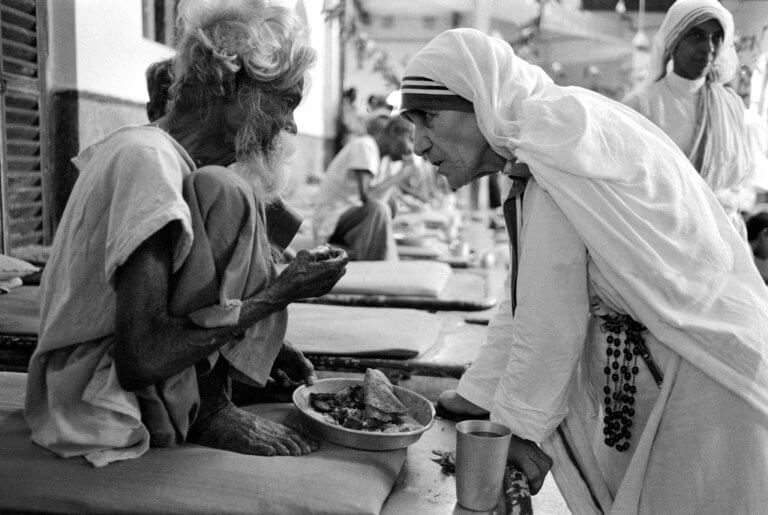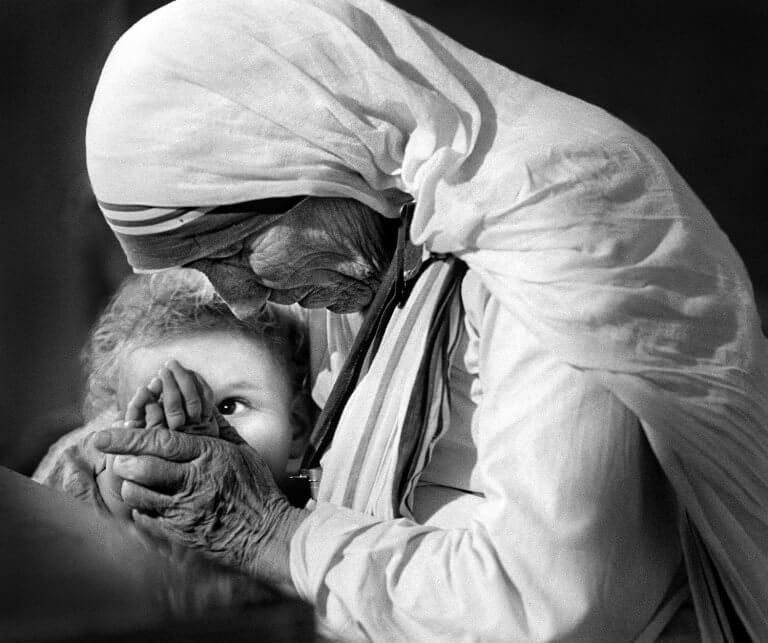On September 5th, the International Day of Charity, the Catholic Church remembers St. Teresa of Calcutta, mother of the poor peole and founder of the Missionaries of Charity Congregation.
The Little Sister of the Poor died in Calcutta on 5 September 1997, surrounded by those to whom she dedicated her life.
All her life and work testify to the joy of loving others tirelessly and to the value of the most insignificant acts done with faith and love. In in the mid-twentieth century marked by secularism, she was an uncompromising witness to traditional religious faith and was able to capture the attention of a wondering world about love?
Agnes Gonxha was born on 27 August 1910 in Skopje in the Ottoman Empire, now Macedonia. Orphan on the father’s side at the age of eight, she grew up in an ordinary poverty.
Driven by the desire to become a missionary like St. Thérèse of Lisieux, whom she greatly admired, she pronounced her religious vows at the age of 21 in Calcutta. That’s when her great mission began.
For twenty years, she taught history and geography to young girls from high society at St. Mary’s College. Filled with deep joy, appreciated by her students who saw her as someone they can trust, she engaged herself in living charity. But on 10 September 1946, her life was turned upside down. On the train to Darjeeling for her annual retreat, Sister Teresa received “the call within the call”. The thirst to love and be loved by the most destitute took possession of her heart.
Next months were marked by trials, but after two years of discernment, she received permission to leave Notre-Dame-de-Lorette. Despite the Church reluctance, she eventually founded the Missionaries of Charity Congregation, whose charism would be “to quench the thirst for Jesus, the thirst for loving souls by working for the salvation and sanctification of the poorest of the poor.”
She abandons the black dress and settles in the slum of Taltla. Her first encounter was with an old woman whose son had thrown her into a waste bin, covered by ants. Among the rubbish and detritus that litter the piles of sheet metal, the little sister in the white sari, bordered by three blue stripes (the three theological virtues: faith, hope and charity; the third, wider stripe representing charity), embraced, fed and cared for the rickety ragpickers. Mother Teresa tirelessly smiled at a child, bent over a sick person, and welcomed a dying old man into her arms. “Today, the most horrible epidemic is not leprosy or tuberculosis. It’s the feeling of being unwanted, rejected, abandoned by everyone.” In these insalubrious labyrinths, the “poor and the lower social classes” die in general indifference. Every night, painful cries rise from the mud houses. On this night in June, she picked up a woman dying on the pavement flooded by the monsoon winds, her toes gnawed by rats.

With strength and courage, she opened her first hostel, the ‘Maison du Cœur pur’ (House of the Pure Heart). “They have lived like beasts all their lives, let them at least die here like human beings.” Every morning, the police brought in those who had died on the pavement during the night. She then opened a home for street children and orphans and had a small town built for lepers.
The nun’s fame soon spread across the world as the little sister of the poor. At the end of the 1960s, Mother Teresa’s appearance on British television and the production of a documentary about her life represents the beginning of her international popularity. Her faith and ability to convince opened every door and every heart. So she has been awarded numerous prizes, including the Nobel Peace Prize in 1979, which she accepted “in the name of the poor”. During her Nobel Prize acceptance speech, she captivated her audience by reciting the prayer attributed to Saint Francis of Assisi, a hymn to love:
Lord, make me a channel of your peace,
that where there is hatred, I may bring love;
that where there is wrong, I may bring the spirit of forgiveness;
that where there is discord, I may bring harmony;
that where there is error, I may bring truth;
that where there is doubt, I may bring faith;
that where there is despair, I may bring hope;
that where there are shadows, I may bring light;
that where there is sadness, I may bring joy.
Unshakeable, St. Teresa of Calcutta pursued her mission to the end, without fail, thanks to prayer, and worked with the most destitute, those whom no one wanted any more: lepers, the mentally ill, orphans…’. There’s something very beautiful about seeing the poor accept their fate, enduring it like the passion of Christ. The world gains so much from their suffering.
The saint of darkness.
But during her consecrated life, Mother Teresa experienced nights of faith doubt, an inner dryness. This painful nights began just after the “call within the call” when God urged her to leave everything. She felt rejected, isolated and neglected, like those to whom she cares. Neverthelesse, her inner pain couldn’t discourage her and drived her to unite herself ever more deeply to the Lord. Like Jesus crying out “I am thirsty” on the cross, ‘I am thirsty for the love of every person’, for more than fifty years she experienced the terrible thirst of Christ’s love for us. Her inner desolation enabled her to understand and share the desolation of the most destitute. She prayed unceasingly, even when exhausted. Times of prayer, abandonment, meditation and Mass were the most important moments of her day.

On 5 September 1997, the Little Sister of the Poor died in her convent in Calcutta, surrounded by those to whom she dedicated her life. Nearly 5,500 sisters in more than 400 centres on 5 continents serve and love Christ by serving the rejected, the unloved and the neglected.
Like Mother Teresa, Saint Vincent de Paul and Sister Emmanuelle, let us pray to the Lord to help volunteers, especially those working with the ragpickers in Cairo, to:
Keep a perpetual joy in the face of life stormes.
Make the unshakeable resolution to prefer others and their good to themselves.
Entrusting themselves in the hands of God during their daily trials.
To remain humble and turned towards God.
On this anniversary of his death, let’s learn to admire the beauty of life, to realise our dreams, to face up to challenges, to overcome sadness, to sing the hymn of life, to accept struggles and to deserve happiness. “Life is life.”
Sources :
http://ici.radio-canada.ca ;
https://www.notrehistoireavecmarie.com ;
https://croire.la-croix.com ;
http://www.chretiensaujourdhui.com/livres-et-textes-et-personnages/les-personnages-celebres/mere-teresa-contemplative-dans-laction/ ;
https://cybercure.fr/grandes-figures/article/sainte-mere-teresa-de-calcutta